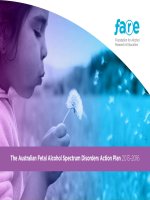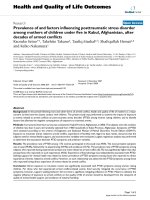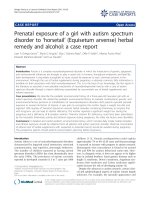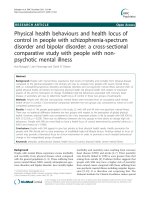Fetal alcohol spectrum disorder among pre-adopted and foster children
Bạn đang xem bản rút gọn của tài liệu. Xem và tải ngay bản đầy đủ của tài liệu tại đây (511.72 KB, 6 trang )
Tenenbaum et al. BMC Pediatrics
(2020) 20:275
/>
RESEARCH ARTICLE
Open Access
Fetal alcohol spectrum disorder among
pre-adopted and foster children
Ariel Tenenbaum*† , Asaf Mandel, Talia Dor, Alon Sapir, Orly Sapir-Bodnaro, Pnina Hertz and Isaiah D. Wexler†
Abstract
Background: Fetal alcohol spectrum disorder (FASD) is a leading cause of neurodevelopmental disorders. Children
in foster care or domestically adopted are at greater risk for FASD. The aim of this study was to determine the
prevalence or risk for FASD in a selected population of foster and adopted children.
Methods: Children between 2 and 12 years who were candidates for adoption in foster care were evaluated for
clinical manifestations and historical features of fetal alcohol spectrum disorder based on established criteria for FASD.
Results: Of the 89 children evaluated, 18 had mothers with a confirmed history of alcohol consumption
during pregnancy. Two children had fetal alcohol syndrome and one had partial fetal alcohol syndrome. In
addition, five had alcohol-related neurodevelopmental disorder, one had alcohol-related birth defects, and a
single child had manifestations of both. Of the 71 children in which fetal alcohol exposure could not be
confirmed, many had manifestations that would have established a diagnosis of FASD were a history of
maternal alcohol consumption obtained.
Conclusions: In a population of high-risk children seen in an adoption clinic, many had manifestations
associated with FASD especially where prenatal alcohol exposure was established. The reported prevalence in
this study is higher than that reported in our previous study of younger children. This is most likely due to
the higher number of children diagnosed with alcohol-related neurodevelopmental disorders that typically
manifest at an older age.
Keywords: Adoption, Alcohol, Congenital anomalies, Fetal alcohol syndrome
Background
Fetal Alcohol Spectrum Disorder (FASD) is a leading
cause of acquired developmental delay in the world [1].
FASD results from the teratogenic effects of alcohol on
the developing fetus, especially during the first trimester
[2]. The manifestations associated with FASD are heterogeneous including highly specific dysmorphia (e.g. smooth
philtrum, thin vermillion border of the upper lip, small palpebral fissures, and head circumference ≤ 10th percentile),
prenatal and/or postnatal growth deficiency, other types of
* Correspondence:
†
Ariel Tenenbaum and Isaiah D. Wexler contributed equally to this work.
Medical Unit for Adoption and Foster Care, Department of Pediatrics,
Hadassah University Medical Center, Mount Scopus Campus, 92140
Jerusalem, IL, Israel
non-specific birth defects, neurodevelopmental abnormalities, and neuroanatomic defects [3–5]. The effects of
exposure to alcohol on the fetus are long term and associated with developmental disabilities, cognitive impairments,
psychiatric disorders, and social maladjustment [4–6]. The
diagnosis of FASD is important for patients and their
families since early intervention, appropriate medical care,
and social support are essential for improving outcome and
quality of life [7], including better adjustment in school,
enhanced interaction with peers, employability, and enhanced social integration.
FASD is highly prevalent in many countries for which
statistics are available. It is estimated that the prevalence
of FASD in populations of younger school children may
be as high as 2–5% in the US and some Western European
© The Author(s). 2020 Open Access This article is licensed under a Creative Commons Attribution 4.0 International License,
which permits use, sharing, adaptation, distribution and reproduction in any medium or format, as long as you give
appropriate credit to the original author(s) and the source, provide a link to the Creative Commons licence, and indicate if
changes were made. The images or other third party material in this article are included in the article's Creative Commons
licence, unless indicated otherwise in a credit line to the material. If material is not included in the article's Creative Commons
licence and your intended use is not permitted by statutory regulation or exceeds the permitted use, you will need to obtain
permission directly from the copyright holder. To view a copy of this licence, visit />The Creative Commons Public Domain Dedication waiver ( applies to the
data made available in this article, unless otherwise stated in a credit line to the data.
Tenenbaum et al. BMC Pediatrics
(2020) 20:275
countries [8]. The incidence is particularly high in children
in orphanages and foster care despite the fact that the diagnosis is often missed [9–13].
It is often difficult to diagnose FASD and the diagnosis
may be missed especially among children who are institutionalized or adopted [11, 14]. In Israel, the number of
documented children carrying the diagnosis of FASD is
extremely low. Senecky et al. reported that during a ten
year period (1998–2007), only 6 patients were listed with a
diagnosis of FASD in two of the four Israeli health maintenance organizations that provide universal health coverage
for Israeli citizens. This is despite the fact that significant
maternal consumption of alcohol during pregnancy has
been documented among Israeli women [15].
In a previous study, we found that among 100 children
seen at an adoption clinic, 15% of the children under the
age of 2 years met the criteria for FASD or would meet
the criteria for a diagnosis of FASD at an older age if
neurocognitive disabilities or certain dysmorphic characteristics were to become recognizable [14]. These findings
suggested that there is an increased prevalence of FASD
in selected populations [10]. Reasons for possible underdiagnosis of FASD could be related to lack of awareness
among health professionals regarding the diagnostic
features of FASD, absence of systematic data collection,
lack of universally accepted diagnostic criteria for the
diagnosis of FAS and FASD, or unawareness of the importance of listing FASD as a diagnostic entity [14–16].
Many of the features of FASD especially those related
to neurodevelopment are diagnosed later in life when
behavioral abnormalities and learning disabilities become more evident. We believe that our previous study
in which only very young children were investigated
underestimated the prevalence of FASD among adopted
or foster children in Israel. We therefore conducted a
study of older children aged 2–12 years among children
who are candidates for adoption or in foster care to determine whether there was an increase in the proportion
of children fulfilling the diagnostic criteria of FASD. This
population was selected because adopted and foster children are at greater risk for having the manifestations of
FASD and the availability of a cohort that is drawn from
a national sample.
Methods
Eighty-nine children between the ages of 2–12 years referred to the Hadassah Mount Scopus Medical Adoption
Unit for medical and developmental assessments were
evaluated. The adoption unit has a contractual agreement with the government of Israel to evaluate children
born in Israel who are in foster care and are potential
candidates for adoption. The study participants were
from all population sectors, socioeconomic status levels,
Page 2 of 6
and geographic areas representative of the general population of Israeli foster children in this age group.
Diagnostic criteria for FASD and clinical manifestations associated with FASD were based on the US Institute of Medicine’s (IOM) diagnostic classification with
modifications introduced by a Canadian Task Force and
Hoyme et al. [17–19]. All of the children in the study
were evaluated by two pediatricians (IW and AT) who
assessed for signs of dysmorphology associated with
FASD utilizing the lip/philtrum guide of Astley and
Clarren [19] and uses a ruler to measure palpebral
fissure length. For assessment of maternal alcohol
consumption, biographical information on the parent(s)
including a history of alcohol consumption during pregnancy prepared by the child’s case worker and a review
of all the children’s medical and social records including
developmental and social assessments. With regard to
neurobehavioral deficits, many cases, children had
already undergone a recent formal developmental assessment at a child development center. If one had not been
performed, a developmental psychologist working in our
clinic performed the assessment and prepared a written
report. It should be noted that in the older Hoyme et al.
criteria, the diagnosis of neurocognitive deficits were
more “gestalt” without specific cutoffs or required number of domains impacted. Information collected during
the evaluation was recorded in the patient’s medical record and subsequently collated. The study was approved
by the Hadassah University Medical Center Institutional
Review Board.
For many of the patients, complete or reliable information was not available for various reasons, including lack
of cooperation of the biological parents in situations in
which children were removed from the home due to
neglect or abuse, children who were found abandoned,
or unreliability of the information obtained (e.g., lack of
external validation related to ethanol consumption). This
is a particularly significant problem associated with this
patient population because most of the categories of
FASD require a confirmed maternal exposure to alcohol.
With reference to maternal alcohol consumption, we
followed the recommendations of the Canadian Task
Force that a history of alcohol consumption during pregnancy was sufficient. Our study population presented
unique problems with regard to prenatal alcohol exposure. The preponderance of children in our study who
were placed in foster care or became candidates for
adoption because of the unavailability of biological parents (abandoned children, parents incapable of raising
children because of intellectual disability, psychiatric disorders, or serious substance abuse) or parents accused of
abuse in which admitting to alcohol usage would damage their legal standing. As such, in many cases it was
difficult to obtain a reliable history of prenatal alcohol
Tenenbaum et al. BMC Pediatrics
(2020) 20:275
exposure. Due to policies of Israel’s Child Services
Agency, we could not contact biological parents. We
adopted a conservative approach to maternal alcohol
consumption. Unless the information was reliable and
confirmed by an outside source (social worker, family),
we did not categorize the mother as having consumed
alcohol during pregnancy.
It should be noted that Hoyme and colleagues have published updated guidelines for the diagnosis of FAS and
FASD [20] and categorization of prenatal alcohol exposure. However, our study was initiated before 2015, and we
utilized the existing criteria available at that time. As part
of the discussion, the impact of the updated criteria as
defined by Hoyme et al. as it relates to the diagnosed cases
of FASD in our study will be discussed.
Since the alcohol consumption history of many mothers
was unknown, we classified children with the clinical signs
of ARND or ARBD without a known maternal history as
being at risk. That is, if a maternal history of alcohol consumption is eventually obtained, then these children
would meet the criteria for a diagnosis of either ARND or
ARBD based on the existing clinical manifestations.
Page 3 of 6
Table 1 Demographic characteristics of patients and biological
parents
Patient’s age (years)
Mean (SD)
5.5 ± 2.24
Median
5.5
Range
2.16–11
Age distribution (n)
2y
13
3–6 y
53
7–12 y
23
Gender
Males
50
Females
39
Religion of parents
Jewish
62
Moslem
2
Christian
0
Mixed
6
Unknown
19
Maternal history
Results
Demographic data for children and patients are shown
in Table 1. For 20.2% of the mothers, there was a confirmed history of alcohol consumption during pregnancy
and for 4.5%, consumption of both alcohol and illicit
drugs. Some of the mothers were involved in high-risk
behaviors such as concomitant drug use or had a partner
consuming drugs and alcohol (Table 1).
The age range for the children in our study population
was 2.16–11.0 years (median 5.5, mean 2.24 ± 5.5) and
the demographic factors including age distribution are
shown in Table 1. Table 2 presents the clinical finding
for both children with confirmed maternal alcohol consumption and those whose mothers either denied alcohol consumption during pregnancy or the history was
unknown. Of the children with documented maternal
exposure to alcohol during pregnancy, two children
fulfilled the criteria for FAS while a third had facial
dysmorphology but lacked the other characteristics (e.g.,
small head circumference for gestational age) of FAS.
Seven children had neurological findings and two had
birth defects. In terms of diagnostic categorization, besides the two patients with FAS, one patient had partial
FAS, five had ARND, one had ARBD, and a single patient had both ARND and ARBD. In summary, 3 children fit the diagnostic criteria for the umbrella diagnosis
of FASD, 3 had neurocognitive manifestations associated
with FASD but did not fulfill all of the criteria for
ARND, and 5 patients who had no manifestations associated with FASD.
Alcohol use
18
Drug use
8
Both
4
Promiscuity
24
Paternal history
Alcohol use
3
Drug use
7
Both
1
Table 2 Clinical characteristics of patientsa
Confirmed maternal Alcohol consumption
alcohol consumption denied or unknown
(n = 18)
(n = 71)
Mean Age (y)
4.6 ± 1.5
5.7 ± 2.4
No abnormalities
4
21
Facial dysmorphology
4
3
Low birth weight
(≤ 10%)
2
1
Failure to thriveb
6
13
Head circumference
≤ 10%
2
1
Neurocognitive/
neurodevelopmental
7
39c
Birth defects
2
4
a
Several children had more than one characteristic
b
Height and/or weight ≤ 10th percentile
c
Three children had neurocognitive signs but were not formally diagnosed
with a neurocognitive disorder
Tenenbaum et al. BMC Pediatrics
(2020) 20:275
Of the children in which maternal exposure to alcohol
during pregnancy could not be documented, three children had facial dysmorphology but none of these patients
had all the diagnostic criteria for FAS were a history of
fetal alcohol exposure to be obtained. A very large number
of children without reported alcohol exposure had clinical
features such as failure to thrive defined as being less than
10% for weight and length, neurological findings, and birth
defects. The frequency of neurocognitive/ neurodevelopmental manifestations was 63%. Only 13 out of 71 children (18.3%) in this group had no clinical manifestations
that could be associated with FASD.
Discussion
In a group of children evaluated in a national medical
adoption unit, 20.2% of the patients had in utero exposure
to alcohol (Table 1). Most likely, this is an underestimation as information regarding alcohol exposure during
pregnancy was not available for many of the mothers.
Among the children with known exposure to alcohol,
nearly half met the criteria for a diagnosis of FASD
(including FASD, partial FASD, ARBD and ARND). Of
the children for whom a history of alcohol exposure could
not be obtained, many would fit the criteria for FASD if
information became available concerning maternal consumption of alcohol.
Comparing the current study to our previous study on
children aged 0–2 years [14], the diagnosed prevalence
of FASD increased with age. This is most likely due to
the fact that ARND is difficult to diagnose during the
first years of life. This is especially true for neurocognitive, behavioral and social adaptation disorders which
are usually diagnosed in the context of an educational
framework. In fact, it is likely that we also underestimated the incidence as it can be challenging to diagnose
subtle learning disabilities and attention deficit in children aged 2–5 y.
In 2016, Hoyme and colleagues published revised criteria for the diagnosis of FASD [20]. For all categories of
FASD, there was a requirement for neurobehavioral impairment with or without cognitive impairment. According to the new criteria, a diagnosis of ARND cannot be
made before the age of 3, and more rigid standards for
the diagnosis of cognitive and behavioral impairments
were established which included the number of cognitive
domains impacted. However, this group did relax the
inclusion criteria for the diagnosis of neurobehavioral
impairment by establishing a cutoff of − 1.5 S.D. in place
of − 2.0 S.D. that are utilized in other published criteria.
As pointed out by Viljoen and colleagues when they
compared the earlier IOM criteria with the revised in
the same cohort, the new criteria resulted in fewer
children receiving a diagnosis of FAS and FASD. These
authors discuss the clinical and social implication related
Page 4 of 6
to the application of the new criteria [21]. In terms of
our study, we may have diagnosed fewer children with
ARND as we used the older criteria.
The high rate of both FASD and the risk for developing FASD is in line with research from other countries.
FASD features were found in more than half of Russian
orphans living in baby homes in Murmansk, Russia [22].
A similar prevalence was found among adopted children
from Eastern Europe [9]. Moreover, previous studies
have also found that children with FASD are overrepresented in foster care and adoption [11–13]. For example,
50% of the surveyed children with FASD or FAS in
Washington State had at least one adoptive parent and
15.4% had foster parents [10].
The current study adds to recent reports suggesting an
increase in alcohol abuse in Israel, especially among
teenagers and young adults which is consistent with
international trends. This is reflected in statistics regarding the increasing abuse of alcohol in the general population [23], alcohol level in fatal casualties in motor
vehicle accidents [24], and the number of children
brought to the emergency room with alcohol poisoning
[25].
Our study raises two questions. First, is there any
intervention possible for women who are at high-risk for
prenatal alcohol exposure such as in our study group.
Here the answer is somewhat pessimistic as there are
many psychosocial factors associated with these mothers
such as psychiatric illnesses, drug abuse, poverty, etc.
What could potentially improve the situation is early
identification of women to either provide them with
familial planning or in the case of women already pregnant, intense social interventions geared to curb drinking behavior. The second question is the applicability of
our study to the general population. The high rate of
prenatal alcohol exposure and the number of children
diagnosed or at risk for FASD should raise the question
of whether the diagnosis of FASD is often overlooked
among Israeli children [11]. One reason might be the
under-reporting of alcohol usage during pregnancy.
Weiss et al. found that among 2477 Israeli women who
gave birth in one medical center between the years
1999–2000, only 1.13% reported drinking alcohol in
small amounts and low frequency during pregnancy
[26]. The researchers of the study questioned their results in comparison to similar studies that found higher
prevalence. It is likely that in this study there was underreporting due to fear from stigmatization, denial and/or
reluctance to share this information. The more recent
study done by the Israel Anti-Drug Authority in 2010
lends support to this assumption as it was found that
out of 3815 women who gave birth in 3 different hospitals, 17.1% reported drinking alcohol during pregnancy
and 0.8% drank excessively at least once in the first
Tenenbaum et al. BMC Pediatrics
(2020) 20:275
trimester [27]. Another possibility for under-diagnosis is
the lack of awareness of healthcare professionals regarding the prevalence of maternal drinking and the diverse
manifestations of FASD [15]. Quite often, the history of
maternal alcohol consumption is not available to mental
health professionals who are evaluating children for developmental or learning disabilities.
In general, real-world diagnosis of FASD remains challenging for the clinician for several reasons. First, there
is still no unified agreed upon criteria for the diagnosis.
Second, many of the updated criteria for diagnosing
FASD especially ARND have become more complicated
and require extensive cognitive and behavioral testing.
Often this requires referral to a specialized center with
expertise in FASD which is often an option not available
to many families. Third, in many cases, information related maternal consumption of alcohol during pregnancy
is either unavailable or unreliable. Fourth, FASD is often
a disorder in evolution, and as we have shown in this
study, the prevalence of FASD increases with age since
many of the clinical manifestations related to dysmorphism and neurocognitive/neurobehavior only become apparent at older ages. Fifth, when assessing neurocognitive
/neurobehavioral status, it is often challenging to assess
the impact of social environmental conditions and adversity on cognitive development.
A limitation particular to this study is the fact that
there were significant psychosocial factors that could
contribute to neurocognitive and neurobehavioral challenges displayed by these subjects. This remains a general challenge associated with the diagnosis of ARND, as
few, if any, neurologic manifestations are specific for
prenatal alcohol exposure [28, 29]. In the old criteria
which were later revised, there was no threshold for the
amount of alcohol [17]. Even when there is a history of
maternal alcohol consumption that is quantifiable, there
is always a question of whether a particular manifestation is related to the toxic effects of alcohol or some
other factor. In any case, it is important for clinicians
and mental health specialists to be aware that maternal
alcohol consumption may have been contributory.
Despite these limitations, it is still important to identify
children who have a very high chance of having FASD so
that they can receive the appropriate intervention. Diagnosis of FASD at an early stage is beneficial as early intervention may minimize many of the cognitive, behavioral, and
social problems associated with FASD [7]. It is also extremely important to identify mothers with a history of
ethanol consumption as this will facilitate early diagnosis
and possibly prevent future cases in the same family [6, 7].
However, because of the stigma which is often linked to
children of FASD and their parents, it is important to
develop approaches that are supportive and encourage
families to bring their children for evaluation.
Page 5 of 6
Conclusions
This study shows that there is a high rate of FASD and
risk for developing FASD in a selected population of
adopted or foster children. This study confirms previous
studies indicating that FASD had been previously underdiagnosed in this high-risk group. Children above the
age of 2 y fitting the criteria for FASD rises as neurodevelopmental and behavioral assessments are more accurate. The findings of our study emphasize the importance
of being aware of FASD especially given the prevalence
of maternal consumption of alcohol during pregnancy.
As intervention is important and potentially beneficial, it
would be important to identify children with FASD or at
risk for developing FASD at an early stage.
Abbreviations
ARBD: Alcohol-related birth defects; ARND: Alcohol-related
neurodevelopmental disorders; FAS: Fetal alcohol syndrome; FASD: Fetal
alcohol spectrum disorder
Acknowledgements
Not applicable.
Authors’ contributions
AT and IDW served as principal investigators and senior authors, they
conceptualized, designed, wrote and reviewed the current manuscript. AM
and AS reviewed charts, extracted data, analyzed the data and produced
tabular results. TD provided scientific and clinical advice regarding
neurological aspects of the research and interpretation of the data. OS and
PH advised on developmental assessments and statistical analysis. The
authors read and approved the final manuscript.
Funding
No funding was obtained for this study.
Availability of data and materials
The datasets used and/or analyzed during the current study are available
from the corresponding author on reasonable request with personal
identifying information removed.
Ethics approval and consent to participate
This study was approved by the Hadassah Medical Organization
Institutional Review Board (IRB). The IRB waived the requirement for
consent based as it was a chart review study of patients receiving
standard care. There was no contact with family members related to the
study. The investigators were blinded to patient identification
information which is the requirement of the Israeli Ministry of Social
Affairs related to adopted children.
Consent for publication
Not applicable.
Competing interests
All the authors declare that they have no competing interests.
Received: 24 October 2019 Accepted: 20 May 2020
References
1. Gupta KK, Gupta VK, Shirasaka T. An update on fetal alcohol
syndrome-pathogenesis, risks, and treatment. Alcohol Clin Exp Res.
2016;40:1594–602.
2. de la Monte SM, Kril JJ. Human alcohol-related neuropathology. Acta
Neuropathol. 2014;127:71–90.
3. Del Campo M, Jones KL. A review of the physical features of the fetal
alcohol spectrum disorders. Eur J Med Genet. 2017;60:55–64.
Tenenbaum et al. BMC Pediatrics
4.
5.
6.
7.
8.
9.
10.
11.
12.
13.
14.
15.
16.
17.
18.
19.
20.
21.
22.
23.
24.
25.
26.
27.
(2020) 20:275
Kodituwakku PW. Neurocognitive profile in children with fetal alcohol
spectrum disorders. Dev Disabil Res Rev. 2009;15:218–24.
Guerri C, Bazinet A, Riley EP. Foetal alcohol Spectrum disorders and
alterations in brain and behaviour. Alcohol Alcohol. 2009;44:108–14.
Fast DK, Conry J. Fetal alcohol spectrum disorders and the criminal justice
system. Dev Disabil Res Rev. 2009;15:250–7.
Jirikowic T, Gelo J, Astley S. Children and youth with fetal alcohol spectrum
disorders: summary of intervention recommendations after clinical
diagnosis. Intellect Dev Disabil. 2010;48:330–44.
Lange S, Probst C, Gmel G, Rehm J, Burd L, Popova S. Global prevalence of
fetal alcohol spectrum disorder among children and youth: a systematic
review and meta-analysis. JAMA Pediatr. 2017;171:948–56.
Landgren M, Svensson L, Strömland K, Andersson GM. Prenatal alcohol
exposure and neurodevelopmental disorders in children adopted from
Eastern Europe. Pediatrics. 2010;125:e1178–85.
Chasnoff IJ, Wells AM, King L. Misdiagnosis and missed diagnoses in
foster and adopted children with prenatal alcohol exposure. Pediatrics.
2015;135:264–70.
Knuiman S, Rijk CH, Hoksbergen RA, van Baar AL. Children adopted from
Poland display a high risk of foetal alcohol spectrum disorders and some
may go undiagnosed. Acta Paediatr. 2015;104:206–11.
Miller LC, Chan W, Litvinova A, Rubin A, Tirella L, Cermak S. Medical
diagnoses and growth of children residing in Russian orphanages. Acta
Paediatr. 2007;96:1765–9.
Lange S, Shield K, Rehm J, Popova S. Prevalence of fetal alcohol
spectrum disorders in child care settings: a meta-analysis. Pediatrics.
2013;132:e980–95.
Tenenbaum A, Hertz P, Dor T, Castiel Y, Sapir A, Wexler ID. Fetal alcohol
spectrum disorder in Israel: increased prevalence in an at-risk population. Isr
Med Assoc J. 2011;13:725–9.
Senecky Y, Inbar D, Diamond G, et al. Fetal alcohol spectrum disorder in
Israel. Isr Med Assoc J. 2009;11:619–22.
Stratton K, Howe C, Battaglia F. Fetal alcohol syndrome: diagnosis,
epidemiology, prevention and treatment. Washington DC: National
Academy Press; 1996.
Chudley AE, Conry J, Cook JL, Loock C, Rosales T, LeBlanc N, et al. Fetal
alcohol spectrum disorder: Canadian guidelines for diagnosis. CMAJ. 2005;
172(5 Suppl):S1–S21.
Hoyme HE, May PA, Kalberg WO, Kodituwakku P, Gossage JP, Trujillo PM,
et al. A practical clinical approach to diagnosis of fetal alcohol spectrum
disorder: clarification of the 1996 institute of medicine criteria. Pediatrics.
2007;115:39–47.
Astley SJ, Stachowiak J, Clarren SK, Clausen C. Application of the fetal
alcohol syndrome facial photographic screening tool in a foster care
population. J Pediatr. 2002;141:712–7.
Hoyme HE, Kalberg WO, Elliott AJ, Blankenship J, Buckley D, Marais AS, et al.
Updated clinical guidelines for diagnosing fetal alcohol Spectrum disorders.
Pediatrics. 2016;138:e20154256.
Viljoen D, Louw JG, Lombard C, Olivier L. Comparing diagnostic outcomes
of children with fetal alcohol syndrome in South Africa with diagnostic
outcomes when using the updated Institute of Medicine diagnostic
guidelines. Birth Defects Res. 2018;110:1335–42.
Miller LC, Chan W, Litvinova A, Rubin A, Comfort K, Tirella L, et al. Fetal
alcohol spectrum disorders in children residing in Russian orphanages: a
phenotypic survey. Alcohol Clin Exp Res. 2006;30:531–8.
Bar-Hamburger R, Ezrahi Y, Rosiner I, Nirel R. Illegal use of drugs and alcohol
in Israel 2009: seventh national epidemiological survey: Israel Anti-Drug
Authority; 2009. Available from: URL: />files/epidemiologic-research-09.doc.
Jaffe DH, Savitzky B, Zaistev K, Hiss J, Peleg K. Alcohol and driver
fatalities in Israel: an examination of the current problem. Isr Med Assoc
J. 2009;11:725–9.
Kozer E, Bar-Hamburger R, Rosenfeld NY, Zdanovitch I, Bulkowstein M,
Berkovitch M. Illicit drug and alcohol users admitted to the pediatric
emergency department. Isr Med Assoc J. 2008;10:779–82.
Weiss S, Sharan H, Merlob P. Self-reported alcohol use among pregnant
women in the center of Israel. Int J Risk Saf Med. 2000;7:27–39.
Senecky Y, Weiss N, Shalev SA, Peleg D, Inbar D, Chodick G, et al. Alcohol
consumption during pregnancy among women in Israel. J Popul Ther Clin
Pharmacol. 2011;18:261–72.
Page 6 of 6
28. May PA, Baete A, Russo J, et al. Prevalence and characteristics of fetal
alcohol spectrum disorders. Pediatrics. 2014;134(5):855–66. />10.1542/peds.2013-3319.
29. Lange S, Rovet J, Rehm J, Popova S. Neurodevelopmental profile of
fetal alcohol Spectrum disorder: a systematic review. BMC Psychol.
2017;5(1):22 2017 Jun 23. />
Publisher’s Note
Springer Nature remains neutral with regard to jurisdictional claims in
published maps and institutional affiliations.









